
Urban Hill
He said:
We visited the Urban Hill restaurant a couple of months ago, but we were too preoccupied at the time to write a review. I was busy throwing a surprise party for Kathy, and she was, well, busy being surprised. Kathy wrote a terrific account of our celebration, which you can read here. Since we had a great time, we thought we should return, this time to pay attention to details so we can share them in a review.
Urban Hill opened in 2022 as one of the first businesses in Salt Lake’s reimagined Post District. Historically, the Post District was an industrial quarter. Throughout the 19th and early 20th centuries, this region of Salt Lake City served as a hub for warehouses, factories, and transportation. Its adjacence to railroad lines made it a key point for distributing goods across the Intermountain West. The district also housed facilities for industries like printing, manufacturing, and logistics.
Driven from their homelands due to famine, political unrest, religious persecution, or even job losses due to agricultural mechanization, many immigrants found their way to Salt Lake City. There, they often joined the west side’s Native Americans, Latter-day Saint settlers, and earlier immigrants from western Europe. A melting pot of Chinese, Japanese, Italian, Greek, Irish, Welsh, and Jewish cultures, among others, supported the area’s industries and contributed to the vibrant economic activity. They provided labor and established businesses that catered to the needs of workers and residents.
Eventually, industry in the area declined. Automation and other modernization made many industrial jobs obsolete. Salt Lake’s diversifying economy further reduced demands for industrial spaces. Changing transportation patterns, such as the decline of railroads in favor of rising trucking and air freight, reduced the district’s advantage of access to rail lines. With the departure of so much industry, the Post District became an overlooked, underutilized area characterized by vacant lots and aging warehouses.
In 2017, the area was designated as an “opportunity zone,” which set the stage for its reimagining. That began its transformation into a mixed-use neighborhood that blends modern urban design with its historical roots. This redevelopment, which is still ongoing, has brought new life to the area and made it a new hub for living, working, and entertaining.
The Urban Hill restaurant embraces this history. Even its building reflects both modern design and its industrial heritage. Exposed steel and brick provide the industrial aesthetic, while the comfortable, welcoming space satisfies more contemporary needs.
Urban Hill strives to “make every dining experience a special occasion,” an aspiration I heartily support. We could see this drive all around us, beginning with the welcoming valet who opened not only our car doors, but the door to the restaurant for us. The hostesses welcomed us with a smile and then rushed to prepare a table for us. Our waiter gave us consistent, efficient service, while engaging us in warm conversation. Assistants quickly refilled our water glasses, delivered dishes, and cleared away our empty plates.
Kathy and I both ordered a zero-proof cocktail. These were more expensive than our typical diet colas—and came without refills, of course—but I like to support establishments that put thought into alcohol-free drinks. I’ve long since grown tired of restaurants that provide dozens of pages of alcoholic offerings, while their most interesting alcohol-free offering might be a simple, pedestrian lemonade. Why should the alcohol-drinkers have all the good drinks? So, while Urban Hill only listed four zero-proof drinks, they obviously put a lot of effort into making them interesting. Kathy ordered the Burro Verde, their take on a Moscow Mule, and I went with the Voyager, their version of a Saturn cocktail.
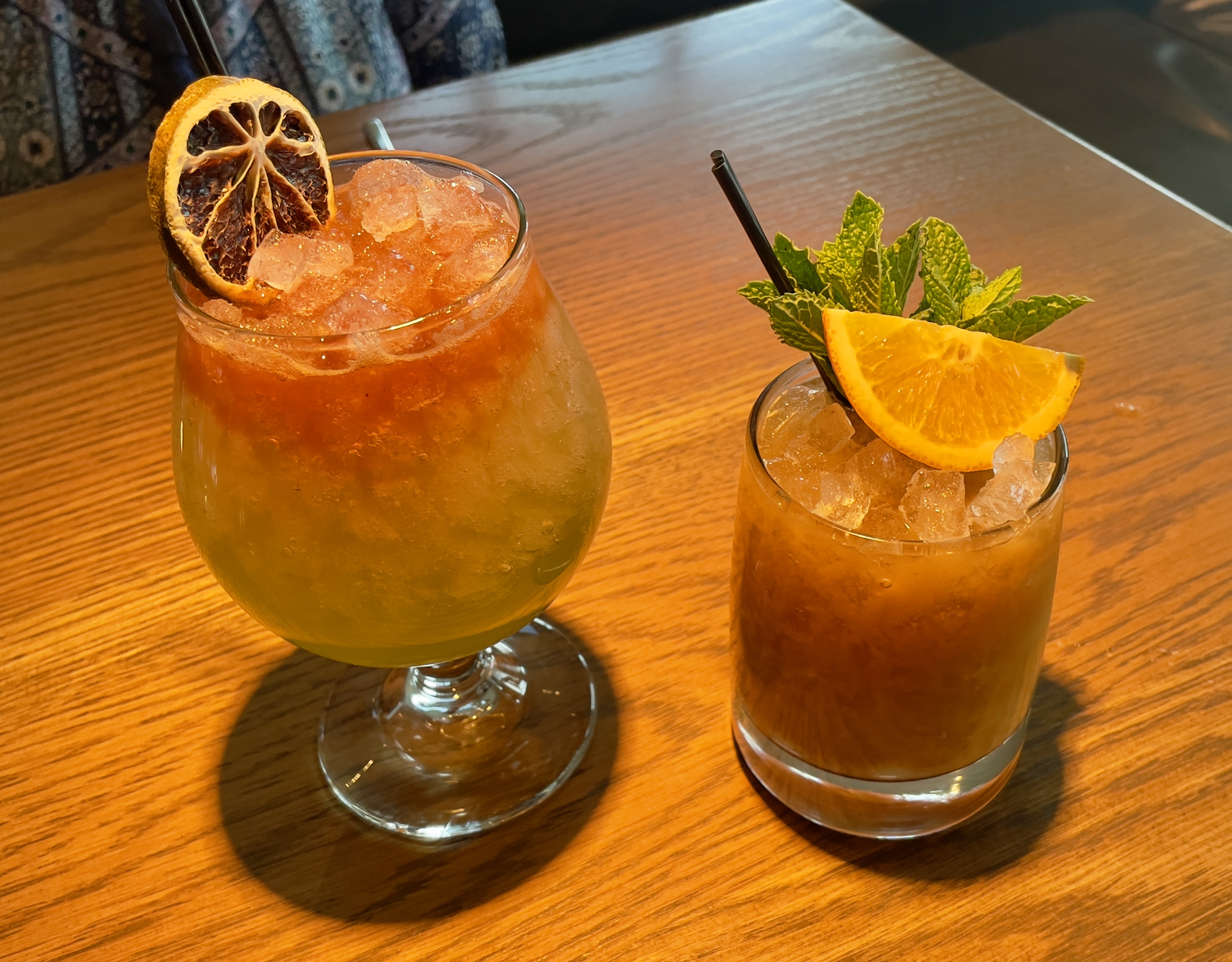
The Voyager had a Pathfinder base. Pathfinder is a brand of non-alcoholic spirit made by fermenting hempseed with specific strains of yeast that develop complex flavors without producing alcohol. Then it is distilled and macerated with a variety of botanicals. In addition to the Pathfinder, the Voyager included orgeat (a syrup made from almonds and floral blossom essences), passionfruit, lemon, orange, and a large sprig of mint.
I began my meal with an order of potato gnocchi, a masterful combination of flavors and textures. It included the pillowy gnocchi, of course, as well as a creamy sweet potato sauce that must have had a splash of lemon juice in it, as it combined both sweetness and a little tartness. Crispy garlic and pecans added nuttiness and crunchiness. Plump golden raisins provided an occasional sweet delight.
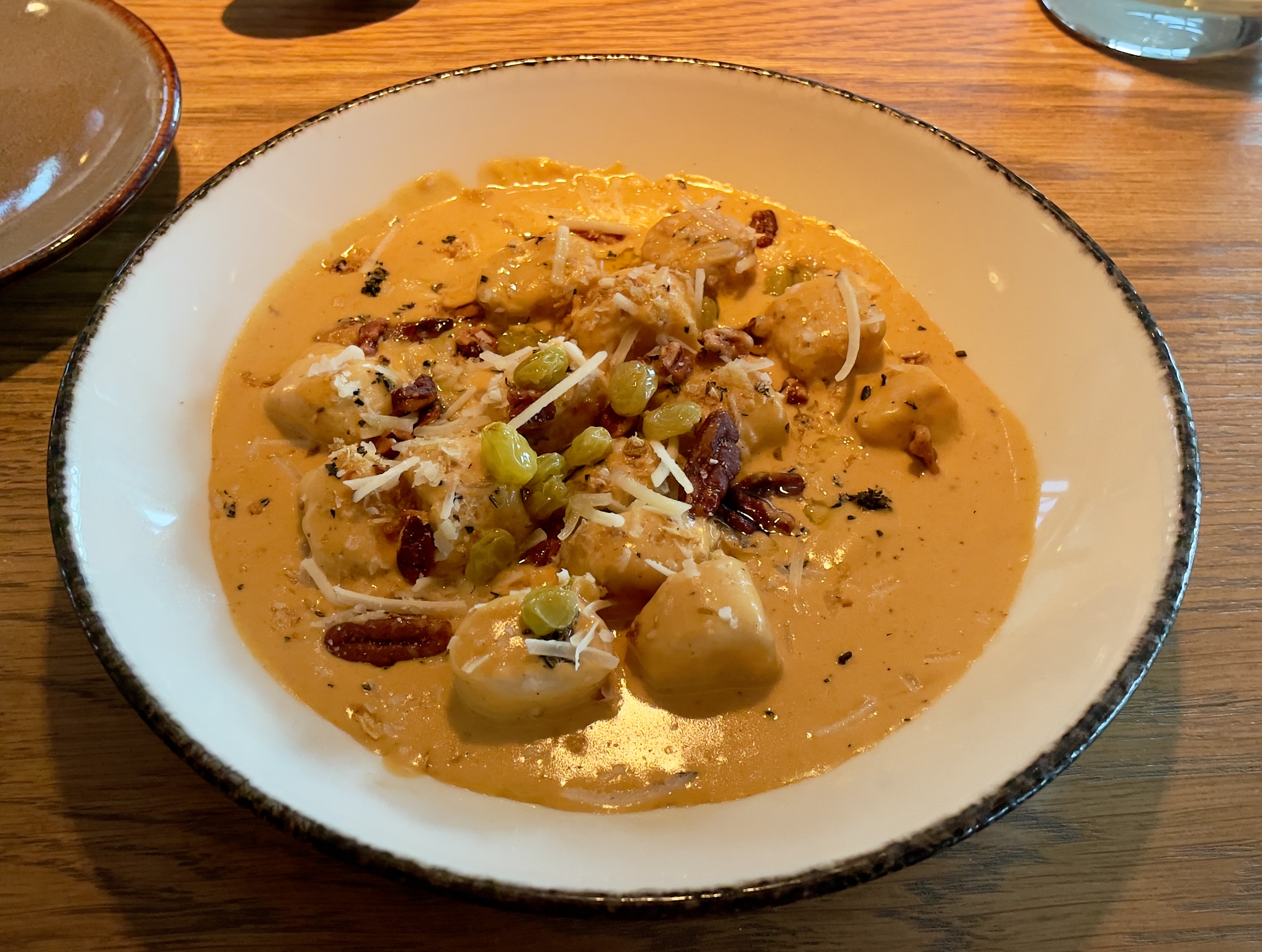
From the guests at our earlier party, I had heard so many good things about the Bison Ribeye that I knew I had to order it. The waiter also spoke well of it, telling us that its preparation and accompaniments honored the bison’s American Southwest heritage. Specifically, the waiter said it incorporated flavors of New Mexico. That was quickly evident, as the dish sat in a pool of black mole and fermented chile. From my very first bite, I realized it would be way too spicy for Kathy, but it suited me just fine. In addition to the spice, the mole had a deep, robust flavor that I enjoyed.
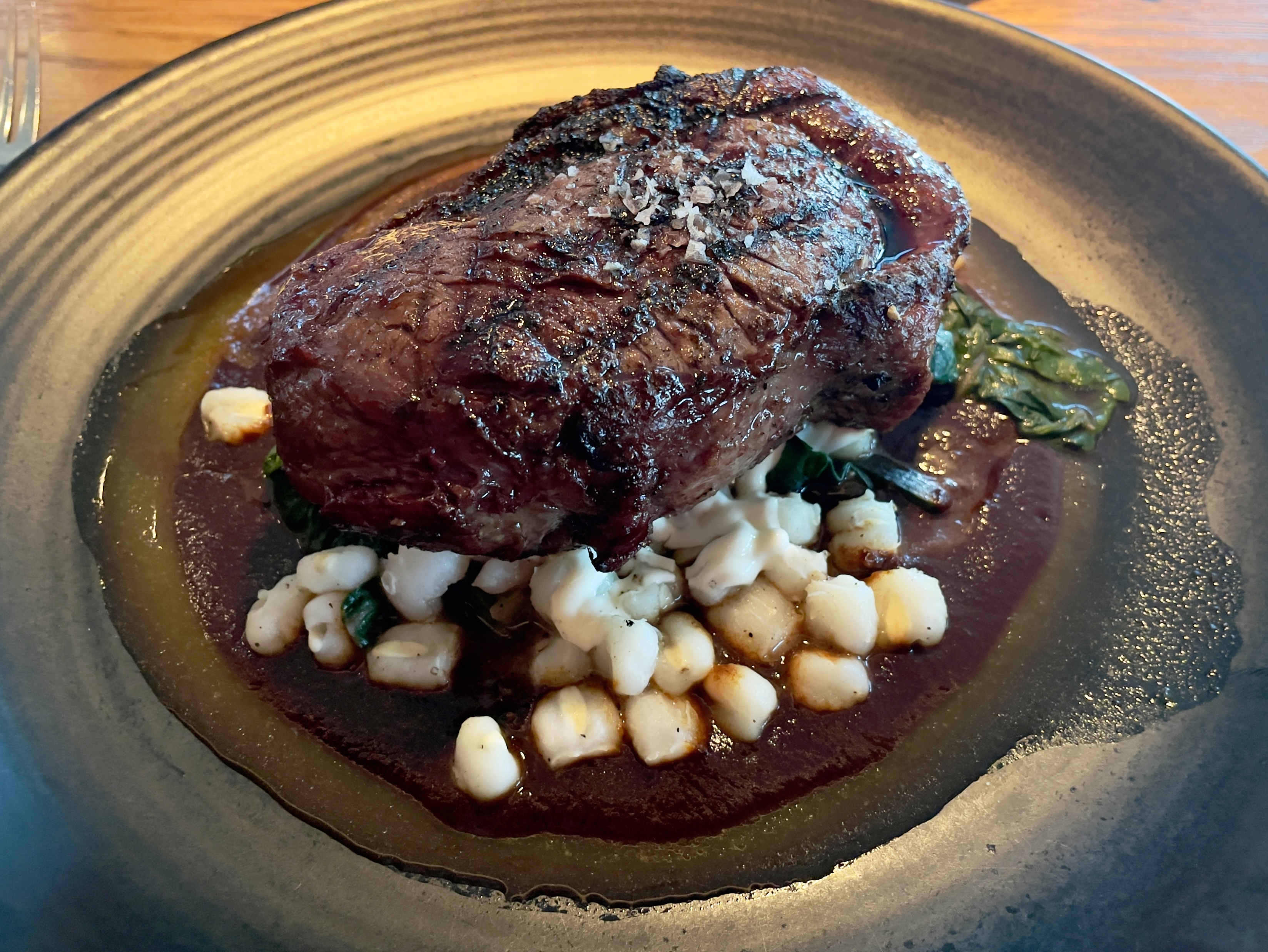
The bison ribeye itself was lean, tender, and satisfying. As I expected, the bison cut lacked the marbling that a beef steak would have possessed. Perhaps that’s why the chef opted for such a bold mole sauce that might have been considered sacrilegious on a beef ribeye. Sautéed chard and smoked hominy accompanied the steak. The chard was fine, though mostly unremarkable. I found the hominy interesting and tasty, but I felt something was missing. Maybe I’m too used to having potatoes with a steak, but I think the real problem is that the steak dominated the dish a little too much. The accompaniments just couldn’t hold their own against it. I would have liked to see some root vegetables, perhaps a grilled carrot or some fingerling potatoes.
She said:
Back in January, when Brian surprised me with a party at Urban Hill, there was only time to revel in the festivities with good friends. Writing a review was not part of the evening’s agenda. However, I did blog about our celebration. Anyway, Brian and I decided to revisit the restaurant for a Thursday night date, and the experience was wonderful once again.
The proprietor of the premises was meticulous with all of the details in opening up a restaurant. The exterior of the building is clad in beautiful red brick. There are wide windows everywhere, framed in black steel. The brick carries through in the interior, where it’s been painted a glossy white. More red-brown brick has been inlaid in the floors. I really love all of that brick. It captures the history of the district, giving the building an air of authenticity.
Once seated, I scanned the room in order to take it all in. Dark oak table tops; greige leather-upholstered chairs; charcoal-colored leather booth benches; dove-gray ceramic light pendants; bronze, inverted-umbrella light fixtures; a blonde wood drop-ceiling above the bar; thick blonde wood partitions; a far wall adorned with what resembled black, stacked shiplap. The pièce de resistance is the completely glassed-in wine vault in the center of the dining room. I’ve never seen so many wine bottles in one place before.
Lastly, I took note of the framed artwork that brought some more warmth to the décor. There was an abstract painting in red, orange, black, and white. There was also a camel-colored cowhide stretched across a frame, and a couple more paintings on the wall in front. One featured buildings that were probably original to the district, with a sky-blue background. The other one outlined a moody teal-blue nighttime skyline with a train and a reddish-brown brick building in the foreground. Very pretty. What’s life without art, anyway?
Now, to the food!
I ordered the French Onion Soup, which was a great choice. It was rich, hearty, flavorful, and cheesy. Perfect and satisfying. The sweet onion, Gruyère, baguette, and seasonings rendered the soup completely delicious. It all made my tastebuds sing. 😋
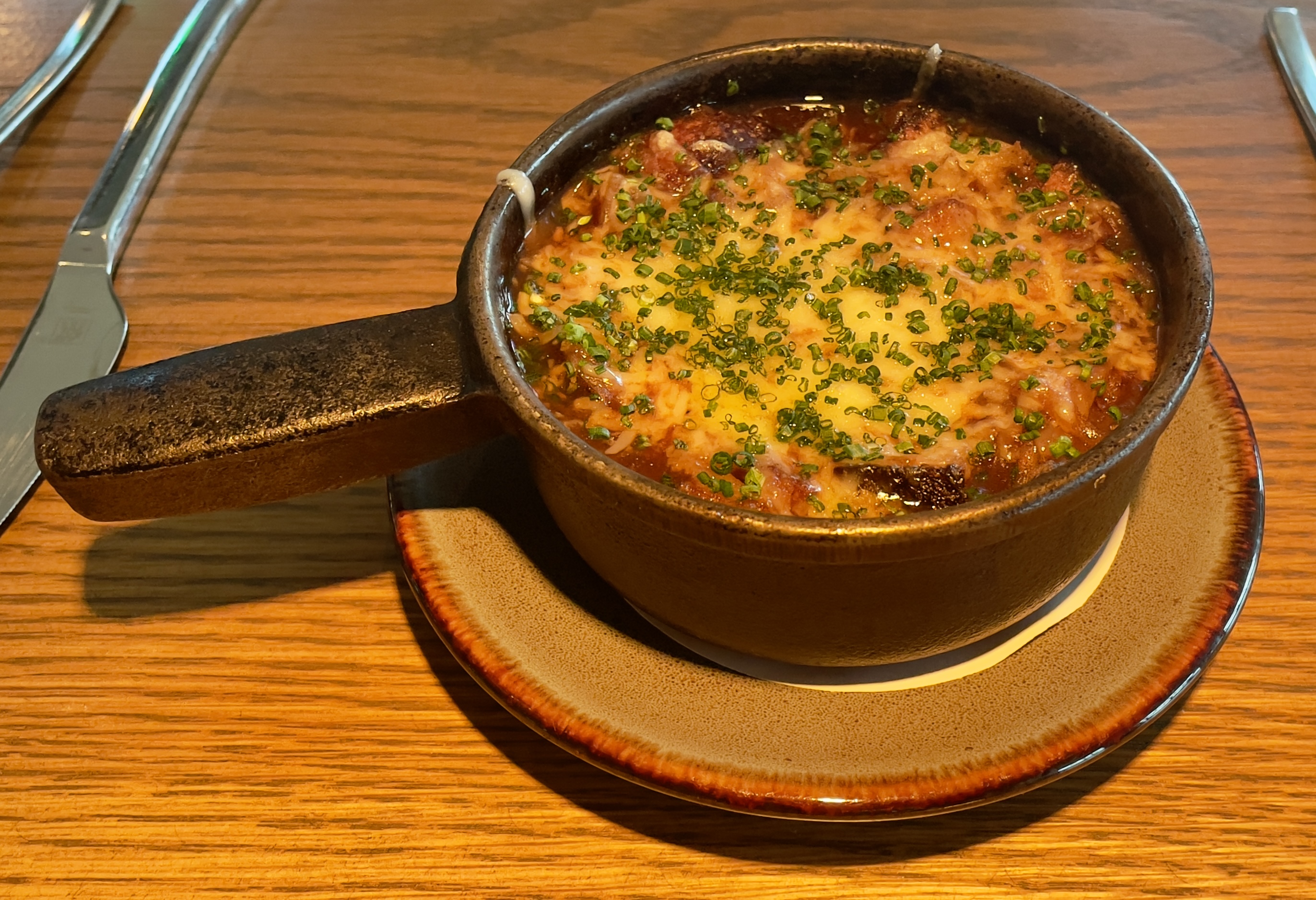
Oh, and my Burro Verde mocktail was superb! Ginger, lime, basil, and bitters. And although the Skillet Rolls that Brian ordered looked and smelled delicious—yeasty and garlicky—I didn’t eat one at the table, but I did take one home to enjoy later. I was saving room for my scallops!
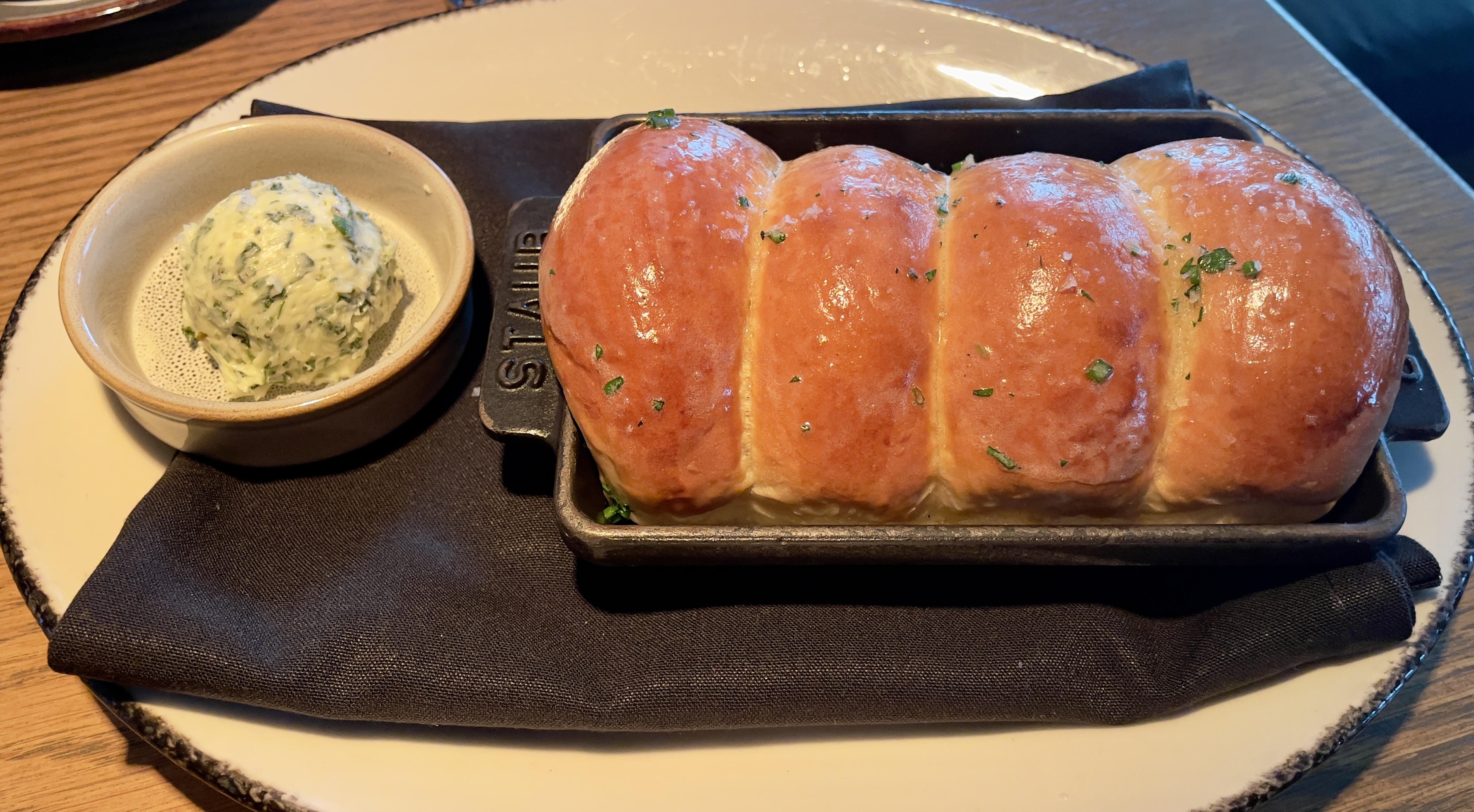
My entrée was served on a white stoneware platter. Pearl couscous rested atop a carrot-ginger-miso purée that made me think of butternut squash, and was topped by a fennel-citrus salad—all flanked by five medium-sized scallops that had been lightly dusted with red chile dust. The purée was really nice, the couscous perfectly al denté, and the scallops lightly seared. They melted in my mouth. The salad included crisp fennel, grapefruit segments, and some sliced yellow grape tomatoes with a tangy vinaigrette. Delectable!
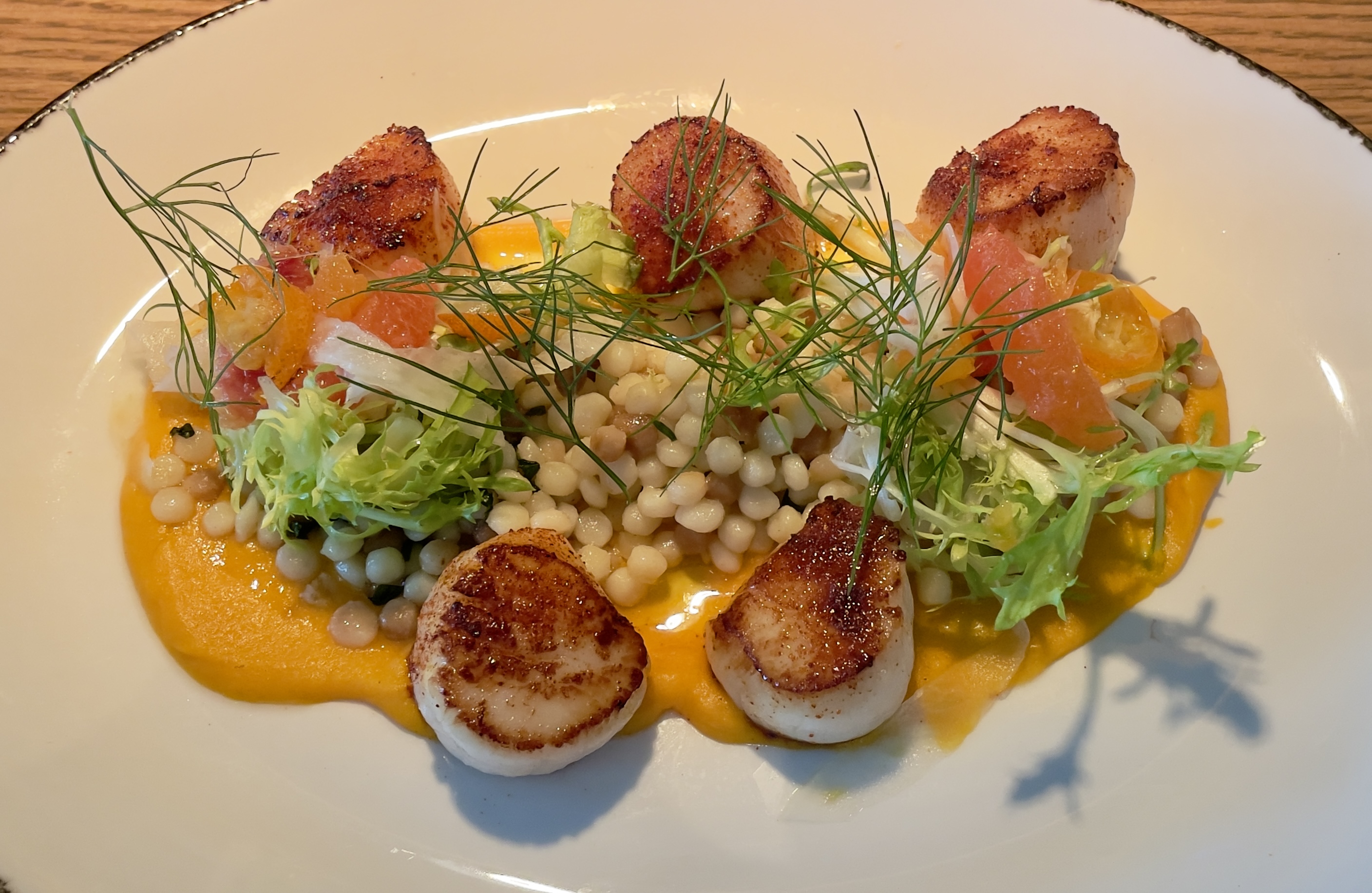
From beginning to end, my personal experience was lovely. As a testament to Urban Hill’s terrific cuisine and hip, modern vibe was its obvious popularity. It was only 5:30 on a Thursday night, but the restaurant vibrated with vibrant and happy chatter from many patrons. The place was filling up fast.
Conclusion:
Let Urban Hill make any of your occasions a special one with their efficient, attentive service, charming ambiance, and inspired cuisine.
Post-Note:
The manager shared with us this recognition of their artists: “We are glad to support some great artists like Samantha DaSilva (the golden calf as well as the two large canvases in the Register Room), Trent Call, and Tom Hagan (German-based photographer with a focus on salt works including the Great Salt Lake).”